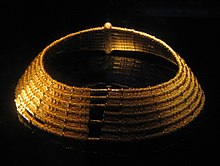Monk collar
The monk collar is a gold neck collar ( Swedish Guldhalskragar ) that was found in 1864 in Möne, north of Ulricehamn in Västergötland in Sweden . It comes from the Nordic Iron Age (375 to 550 AD - comparable to the Central European Migration Period ).
description
The monk's collar consists of seven superimposed, interconnected gold rings. They can be opened at the front and can be bent apart using a hinge installed on the back . The neck size of the monk collar is 152 millimeters, its weight is a little more than 820 grams. The monkey collar is the largest gold collar in Sweden and shows 458 animal figures in filigree technique .
The monk collar was found by Johannes Andersson from Möne when he was removing a pile of stones and struck four limestone slabs, under which the gold collar was hidden. The Reichsantiquar Bror Emil Hildebrand (Reichsantiquar from 1837 to 1879) came from Stockholm to pick up the find. Johannes Anderson is said to have received 2123 riksdalers and 57 ore silver coins as a reward. Like the two gold neck collars previously found in Sweden, the monk's collar was a single find. The other two gold neck collars are the Ålleberg collar from Västergötland, found in 1827, and the Färjestad collar from Öland , found in 1860.
context
The more than 30 gold finds in Sweden, mainly from the Nordic Iron Age, are related to the fall of the Roman Empire in the second half of the 5th century. Large amounts of Roman gold came into circulation, paid to soldiers who had served in the army or came from looting. The gold of the seven-ring monk's collar probably also comes from the Roman Empire.
The three gold neck collars are kept in the State Historical Museum (Statens historiska museum) in Stockholm . In 1986 there was a break-in at the museum. After that, the gold neck collars were no longer made available to the public. Instead, from 1987 onwards, copies made at the Roman Germanic Central Museum in Mainz were shown. In 1994 the gold chamber (Guldrummet) was opened in the State Historical Museum , in which the originals are again exhibited in secure display cases.
See also
Individual evidence
- ↑ Jan Peder Lamm: On the taxonomy of the Swedish gold neck collar of the migration period. Fornvännen, Journal of Swedish Antiquarian Research, 86, 1991, pp. 153-167. ( PDF , Digitala Vetenskapliga Arkivet, Swedish).
- ^ A b c Kent Andersson: Gyllene Berattelser . Statens Historiska Museum, 2004 (Swedish)
- ^ Mårten Stenberger: Nordic prehistory. Volume 4: Prehistory of Sweden. Wachholtz, Neumünster 1977, p. 319, ISBN 3-529-01805-8 .
- ↑ Collar från Möne, Västergötland. Bengans Historiasidor, 2008 (Swedish)
- ↑ The Riksdaler was the official currency of Sweden between 1777 and 1873. It was named after the Reichstaler in Germany.
- ↑ Alexandra Pesch: The power of animals. Gold neck collars from the Migration Period and the principles of Germanic art. Pre- and early-historical antiquities catalogs, Volume 47, Verlag des Römisch-Germanisches Zentralmuseums, Mainz 2015, pp. 15–16, ISBN 978-3-88467-240-2
literature
Used literature
- Jan Peder Lamm: On the taxonomy of the Swedish gold neck collar of the migration period. Fornvännen, Journal of Swedish Antiquarian Research, 86, 1991, pp. 153-167. ( PDF , Digitala Vetenskapliga Arkivet, Swedish).
- Alexandra Pesch: Dragon gold. Treasure finds of the north in the first millennium AD. In: Heike Sahm, Wilhelm Heizmann, Victor Millet (ed.): Gold in the European heroic saga. De Gruyter, Berlin 2019, pp. 13–34, ISBN 978-3-11-061415-2
- Alexandra Pesch: The power of animals. Gold neck collars from the Migration Period and the principles of Germanic art. Catalogs of Prehistoric Antiquities, Volume 47, Verlag des Römisch-Germanisches Zentralmuseums, Mainz 2015, ISBN 978-3-88467-240-2
further reading
- Jan Peder Lamm: gold neck collar. In: Reallexikon der Germanischen Altertumskunde (RGA). 2nd Edition. Volume 12, Walter de Gruyter, Berlin / New York 1998, ISBN 3-11-016227-X , pp. 335–343. Online edition (fee required) at GAO , De Gruyter .
- Wilhelm Holmqvist: Guldhalskaragarna. FT Förlag i samarbete med Statens Historiska Museum, Stockholm 1980.
- Heide Wrobel Nørgaard: The Collars of the Nordic Bronze Age 2009 PDF
Web links
- Kent Andersson: Gyllene Berattelser . Statens Historiska Museum, 2004 (Swedish)
- Collar från Möne, Västergötland. Bengans Historiasidor, 2008 (Swedish)


